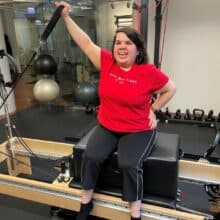Best of 2015: How Do Blind People Identify and Match Their Clothes Each Day?
Once again, we bring you the most popular posts of 2015. This week, we share our second-most popular post, How do blind people identify and match their clothes each day?
Thanks for reading and making the first year of Sandy’s View a huge hit!
Perhaps one of the greatest challenges people who are blind or visually impaired face is matching and identifying clothing. Good organization and creativity skills can help in this process. However, there is no standard method for clothes matching and identification, and the techniques I will discuss are only a handful of the many ways people with visual impairments have discovered and used over the years.
Mary Abramson is an instructor in the Office Skills program at the Chicago Lighthouse. She has been visually impaired since birth, and her vision has gradually diminished over the years. As a result she has had to find new and creative ways to coordinate her clothes.
Finding someone she trusts and who has similar perceptions of color to her own is one of Mary’s most important criteria when choosing and buying her clothes. This person can assist Mary in describing the items to her and help her decide which clothes match her style and preference.
Once Mary has purchased the clothing, she must immediately find a way to label and organize it in order to avoid any unnecessary confusion. This is where her organization skills come in handy! Mary utilizes a variety of methods such as labeling clothes with Braille tags and using a certain number of safety pins to know what color each piece is.
Depending on the situation, she decides how and what to label. If, for instance, one of her shirts has a particularly distinguishable tactile feature she will immediately know its color. On the other hand, if the shirt is similar or identical to others, she might decide to put a Braille tag labeled with the shirt’s color.
It’s equally important for Mary to know what outfits match, so she must somehow identify them. To do this, she might put a certain number of safety pins, ponytail holders, or anything that won’t get easily ruined in the washing machine on to each matching piece. For example, she’ll know that the shirt that has two safety pins goes with the pants that also have two safety pins.
When it comes to shoes, Mary has to be extra careful to make sure that each pair somehow stays together – she’s well aware that wearing one black and one brown shoe is not the latest fashion trend! If the shoes are the same style, Mary separates them by putting each pair in a plastic bag labeled in Braille with the color, or – in the case of shoes with laces – by tying them together.
The same applies to socks or any other item that comes in pairs. Mary must find a way to keep each pair together even while it’s in the washing machine – once again safety pins come to the rescue!
Many technological products have been developed that identify colors. These are either stand-alone devices or Smartphone apps. When the user points the device to a piece of clothing, it will verbally announce the color. Although this technology has come a long way, many improvements still have to be made in order for it to be considered a reliable method. For example, it is still not capable of distinguishing different shades of the same color. Someone who is blind might be told that two pairs of pants are navy blue, but the person won’t know what shade of navy blue each pants are.
When it comes to coordinating clothes, many methods can help. The key is finding one or more techniques that will be easy to manage and are reliable for each person. Like Mary, I have found that being organized and using a combination of methods will enable me to have a well-coordinated wardrobe.
Read about other methods that people who are visually impaired use to select their clothing here. Feel free to share other tips or techniques you have found useful. Thanks for reading!





